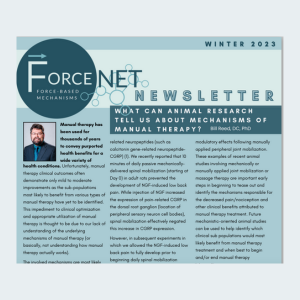
Professor in Population Health Sciences
Member in the Duke Clinical Research Institute
Home
Vision Statement:
ForceNET endeavors to bridge the knowledge gap between research in force-based mechanisms and outcomes relevant to patients and their clinicians.
Mission Statement:
ForceNET exists to connect interdisciplinary force-based mechanisms (FBM) researchers and/or clinicians of diverse backgrounds to address notable gaps in mechanistic-related knowledge, create a platform for sharing and dissemination of this knowledge, financially support pilot research to address identified mechanistic knowledge gaps, and when appropriate, frame and integrate the new knowledge into a clinical context.
ForceNET’s core objectives align with NCCIH’s 2021-2025 strategic plan.
Research
Vision Statement:
ForceNET endeavors to bridge the knowledge gap between research in force-based mechanisms and outcomes relevant to patients and their clinicians.
Mission Statement:
ForceNET exists to connect interdisciplinary force-based mechanisms (FBM) researchers and/or clinicians of diverse backgrounds to address notable gaps in mechanistic-related knowledge, create a platform for sharing and dissemination of this knowledge, financially support pilot research to address identified mechanistic knowledge gaps, and when appropriate, frame and integrate the new knowledge into a clinical context.
ForceNET’s core objectives align with NCCIH’s 2021-2025 strategic plan.
ForceNET’s Objectives:
Objective 1: Characterize and quantify mechanical forces associated with FBMs using universally accepted scientific metrics and terminology
Objective 2: Create RFA’s to fund force-based mechanism pilot research involving applied forces, biomechanical and neural mechanisms of mechanotransduction, and contextual effects
Objective 3: Enhance the Integrative Health Research Workforce. We will:
1) establish/cultivate a community of interdisciplinary collaborations between public and private university-based and hospital-based researchers;
2) actively develop preclinical models;
3) implement an innovative pilot project research program;
4) provide information for collaborators; and
5) implement a multi-faceted dissemination plan
Objective 4: Foster translational education and research that improves understanding and guides clinical decision making for clinicians who use force-based interventions
Objective 5: Provide ongoing, sustainable initiatives for the continued relevance and success of ForceNET
People
Executive Team

Dr. Bill Reed |

Dr. Dawn Elliot |

Dr. Greg Kawchuk |

Dr. Vitaly Napadow |
Publications
Selected Publications
Bialosky, J. E., et al. (2018). “Unraveling the mechanisms of manual therapy: modeling an approach.” journal of orthopaedic & sports physical therapy 48(1): 8-18.
Bialosky, J. E., et al. (2008). “The influence of expectation on spinal manipulation induced hypoalgesia: an experimental study in normal subjects.” BMC Musculoskeletal Disorders 9(1): 1-9.
Bialosky, J. E., et al. (2014). “Spinal manipulative therapy–specific changes in pain sensitivity in individuals with low back pain (NCT01168999).” The Journal of Pain 15(2): 136-148.
Bolton, P. S. and B. Budgell (2012). “Visceral responses to spinal manipulation.” Journal of Electromyography and Kinesiology 22(5): 777-784.
Chow, N., et al. (2021). “Assessment of studies evaluating spinal manipulative therapy and infectious disease and immune system outcomes: a systematic review.” JAMA network open 4(4): e215493-e215493.
Côté, P., et al. (2020). “A united statement of the global chiropractic research community against the pseudoscientific claim that chiropractic care boosts immunity.” Chiropractic & Manual Therapies 28(1): 1-5.
de Toledo, D. d. F. A., et al. (2020). “High-velocity, low-amplitude manipulation (HVLA) does not alter three-dimensional position of sacroiliac joint in healthy men: a quasi-experimental study.” Journal of Bodywork and Movement Therapies 24(1): 190-193.
den Bandt, H. L., et al. (2019). “Pain mechanisms in low back pain: a systematic review with meta-analysis of mechanical quantitative sensory testing outcomes in people with nonspecific low back pain.” journal of orthopaedic & sports physical therapy 49(10): 698-715.
Dreischarf, M., et al. (2016). “Estimation of loads on human lumbar spine: A review of in vivo and computational model studies.” Journal of biomechanics 49(6): 833-845.
Ellingsen, D.-M., et al. (2018). “Brain mechanisms of anticipated painful movements and their modulation by manual therapy in chronic low back pain.” The Journal of Pain 19(11): 1352-1365.
Gay, C. W., et al. (2014). “Immediate changes after manual therapy in resting-state functional connectivity as measured by functional magnetic resonance imaging in participants with induced low back pain.” Journal of manipulative and physiological therapeutics 37(9): 614-627.
Gevers‐Montoro, C., et al. (2021). “Neurophysiological mechanisms of chiropractic spinal manipulation for spine pain.” European Journal of Pain 25(7): 1429-1448.
Isenburg, K., et al. (2021). “Increased salience network connectivity following manual therapy is associated with reduced pain in chronic low back pain patients.” The Journal of Pain 22(5): 545-555.
Lascurain-Aguirrebena, I., et al. (2016). “Mechanism of action of spinal mobilizations: a systematic review.” Spine 41(2): 159-172.
Lima, C. R., et al. (2020). “Physiological responses induced by manual therapy in animal models: a scoping review.” Frontiers in Neuroscience: 430.
Matyas, J. R., et al. (2021). “Repetitive in vivo manual loading of the spine elicits cellular responses in porcine annuli fibrosi.” PloS one 16(3): e0248104.
Meyer, A.-L., et al. (2019). “Unravelling functional neurology: does spinal manipulation have an effect on the brain?-a systematic literature review.” Chiropractic & Manual Therapies 27(1): 1-30.
Mörl, F., et al. (2020). “Loads distributed in vivo among vertebrae, muscles, spinal ligaments, and intervertebral discs in a passively flexed lumbar spine.” Biomechanics and modeling in mechanobiology 19(6): 2015-2047.
Palmowski, Y., et al. (2021). “In vivo analysis of hip joint loading on Nordic walking novices.” Journal of Orthopaedic Surgery and Research 16(1): 1-10.
Picchiottino, M., et al. (2019). “The acute effects of joint manipulative techniques on markers of autonomic nervous system activity: a systematic review and meta-analysis of randomized sham-controlled trials.” Chiropractic & Manual Therapies 27(1): 1-21.
Reed, W. R., et al. (2020). “Spinal mobilization prevents NGF-induced trunk mechanical hyperalgesia and attenuates expression of CGRP.” Frontiers in Neuroscience 14: 385.
Reed, W. R. and J. G. Pickar (2015). “Paraspinal muscle spindle response to intervertebral fixation and segmental thrust level during spinal manipulation in an animal model.” Spine 40(13): E752.
Sliz, D., et al. (2012). “Neural correlates of a single-session massage treatment.” Brain imaging and behavior 6(1): 77-87.
Tullberg, T., et al. (1998). “Manipulation does not alter the position of the sacroiliac joint: a roentgen stereophotogrammetric analysis.” Spine 23(10): 1124-1128.
Vigotsky, A. D. and R. P. Bruhns (2015). “The role of descending modulation in manual therapy and its analgesic implications: a narrative review.” Pain research and treatment 2015.
Voogt, L., et al. (2015). “Analgesic effects of manual therapy in patients with musculoskeletal pain: a systematic review.” Manual therapy 20(2): 250-256.
Weber II, K. A., et al. (2019). “Evidence for decreased Neurologic Pain Signature activation following thoracic spinal manipulation in healthy volunteers and participants with neck pain.” NeuroImage: Clinical 24: 102042.
Wong, A. Y., et al. (2015). “Do participants with low back pain who respond to spinal manipulative therapy differ biomechanically from nonresponders, untreated controls or asymptomatic controls?” Spine 40(17): 1329-1337.
Zhang, Q., et al. (2021). “Techniques for in vivo ligament and tendon strain measurement: a review.” Annals of Biomedical Engineering 49(1): 7-28.
Research Opportunities
ForceNET Membership Benefits
Thank you for your interest in joining ForceNET. ForceNET is an NIH-funded U24, created to sponsor and review U24 pilot grants and build a network of force-based mechanisms researchers. All interested individuals are encouraged to join; there are no licensure requirements and you do not need to be a researcher. There are no costs to joining ForceNET, but several potential benefits exist. These include:
- Eligibility to submit for a U24 pilot grant (if the individual meets the NIH requirements RFA)
- Periodic newsletter
- Free attendance at webinars
- Access to YouTube library of training materials
- Access and inclusion to a membership directory for networking opportunities
- Updated messaging regarding conferences, pilot funding opportunities, and other NIH events
Selected ForceNET members also may have the opportunity to contribute to “U24 working groups”, “review U24 pilot grants”, “participate in consensus panels”, “present in webinars” and contribute to “publishing in special issues”. Those with interests in these additional areas should contact Dr. Bill Reed by email at wreed@uab.edu or office phone +1 (205) 934-3261 or Dr. Chad Cook by email at chad.cook@duke.edu or office phone +1 (919) 684 8905.
